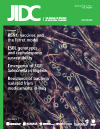The current state of H5N1 vaccines and the use of the ferret model for influenza therapeutic and prophylactic development
DOI:
https://doi.org/10.3855/jidc.2666Keywords:
influenza, H5N1, vaccines, influenza vaccine, DNA vaccine, reverse genetics, seasonal influenza, ferret, ferret model, adjuvant, cold adapted vaccinesAbstract
Highly pathogenic avian influenza H5N1 is a threat to global public health as a natural pandemic causing agent but has recently been considered a bioterrorism concern. The evolving view of the H5N1 virus necessitates the re-evaluation of the current status of H5N1 therapeutics and prophylactics, in particular the preparation of viable H5N1 vaccination strategies as well as the use of ferrets in influenza research. Here the highly pathogenic H5N1 virus dilemma is discussed in context with the current H5N1 vaccine status and the use of the ferret model. Previously, the development of various H5N1 vaccine platforms have been attempted, many of them tested in the ferret model, including vector vaccines, adjuvant vaccines, DNA vaccines, and reverse engineered vaccines. Moreover, as ferrets are a superlative animal model for influenza investigation and vaccine testing, it is imperative that this model is recognized for its uses in prophylactic development and not only as an agent for creating transmissible influenza viruses. Elucidating the ferret immune response and creating ferret immune reagents remain important goals in conjunction with the development and manufacture of H5N1 vaccines. In summary, an efficacious H5N1 vaccine is urgently needed and the ferret model remains an appropriate model for its development.Downloads
Published
2012-05-15
How to Cite
1.
Banner D, Kelvin AA (2012) The current state of H5N1 vaccines and the use of the ferret model for influenza therapeutic and prophylactic development. J Infect Dev Ctries 6:465–469. doi: 10.3855/jidc.2666
Issue
Section
Emerging Problems in Infectious Diseases
License
Authors who publish with this journal agree to the following terms:
- Authors retain copyright and grant the journal right of first publication with the work simultaneously licensed under a Creative Commons Attribution License that allows others to share the work with an acknowledgement of the work's authorship and initial publication in this journal.
- Authors are able to enter into separate, additional contractual arrangements for the non-exclusive distribution of the journal's published version of the work (e.g., post it to an institutional repository or publish it in a book), with an acknowledgement of its initial publication in this journal.
- Authors are permitted and encouraged to post their work online (e.g., in institutional repositories or on their website) prior to and during the submission process, as it can lead to productive exchanges, as well as earlier and greater citation of published work (See The Effect of Open Access).








